roof SUBARU WRX 2018 Owners Manual
[x] Cancel search | Manufacturer: SUBARU, Model Year: 2018, Model line: WRX, Model: SUBARU WRX 2018Pages: 578, PDF Size: 33.21 MB
Page 15 of 578

(14,1)
北米Model "A1700BE-B" EDITED: 2017/ 10/ 11
Illustrated index&Exterior!TYPE RA
1) Engine hood (page 11-9)
2) Front wiper (page 3-72)
3) Headlight (page 3-64)
4) Replacing bulbs (page 11-44)
5) Carbon roof (page 10-3)
6) Door locks (page 2-4)
7) Outside mirrors (page 3-83)
8) Tire pressure (page 11-32)
9) Flat tires (page 9-5)
10) Snow tires (page 8-9)
11) Tie-down hooks (page 9-21)
12) Towing hook (page 9-21)
12
Page 17 of 578

(16,1)
北米Model "A1700BE-B" EDITED: 2017/ 10/ 11
!Other models
1) Engine hood (page 11-9)
2) Front wiper (page 3-72)
3) Headlight (page 3-64)
4) Replacing bulbs (page 11-44)
5) Moonroof (page 2-38)
6) Door locks (page 2-4)
7) Outside mirrors (page 3-83)
8) Tire pressure (page 11-32)
9) Flat tires (page 9-5)
10) Snow tires (page 8-9)
11) Fog light (page 3-72)
12) Tie-down hooks (page 9-21)
13) Towing hook (page 9-21)
14
Page 30 of 578

(29,1)
北米Model "A1700BE-B" EDITED: 2017/ 10/ 11
Function settingsA SUBARU dealer can change the settings of the functions shown in the following table to meet your personal requirements. Contact
your nearest SUBARU dealer for details. In addition, you can change the settings for some of these functions using the multi-function
display (color LCD). For more information, refer to“Multi-function display (color LCD)”F3-44.Item Function Possible settings Default setting Page
Alarm system Alarm system Operation/Non-operation Operation 2-24
Monitoring start delay time (after closure of doors) 0 seconds/30 seconds 30 seconds 2-25
Impact sensor operation (only models with shock
sensors (dealer option))Operation/Non-operation Non-operation 2-30
Passive arming (models without“keyless access
with push-button start system”)Operation/Non-operation Non-operation 2-29
Dome light and map lights (models with moonroof)
illuminationON/OFF OFF 2-24
Keyless access (if equipped) Hazard warning flasher Operation/Non-operation Operation 2-11
Audible signal Operation/Non-operation Operation 2-14
Audible signal volume Level 1 - 7 Level 5 2-14
Door unlock selection function (driver’s door
unlock)Driver’s door only/All
doorsDriver’s door
only2-12
Remote keyless entry system Hazard warning flasher Operation/Non-operation Operation 2-18
Audible signal Operation/Non-operation Operation 2-20
Audible signal volume Level 1 - 7 Level 5 2-20
Remote trunk open function Activation of trunk opening by remote transmitter/
access key fobOperation/Non-operation Operation 2-20
Key lock-in prevention Key lock-in prevention Operation/Non-operation Operation 2-7
Defogger and deicer system for
models with the automatic climate
control systemRear window defogger, outside mirror defogger
and windshield wiper deicerOperation for 15 minutes/
Continuous operationOperation for
15 minutes3-84
–CONTINUED–
27
0
Page 31 of 578

(30,1)
北米Model "A1700BE-B" EDITED: 2017/ 10/ 11
Item Function Possible settings Default setting Page
Dome light Operation of dome light/map light OFF delay timer OFF/10 seconds/20 sec-
onds/30 seconds30 seconds 6-3
Map light (models with moonroof)
Battery drainage prevention function Battery drainage prevention function Operation/Non-operation Operation 2-6
Seatbelt warning Sounds a chime while driving Operation/Non-operation Operation 3-14
Auto on/off headlights (if equipped) Sensitivity of the operation of the auto on/off
headlightsLow/Normal/High/Very
highNormal 3-64
Windshield wiper Auto-on/off wiper linked headlights Operation/Non-operation Operation 3-64
Auto dimmer cancel Sensitivity of the operation of the auto dimmer
cancelOFF/Min/Low/Mid/Hi/Max Mid 3-71
Welcome lighting Approaching (operation of timer) OFF/30 seconds/60 sec-
onds/90 seconds30 seconds 3-64
Exiting (operation of timer)
High beam assist function (models
with the EyeSight system)High beam assist function Operation/Non-operation Operation 3-65
One-touch lane changer Operation of the one-touch lane changer Operation/Non-operation Operation 3-7028
Page 37 of 578
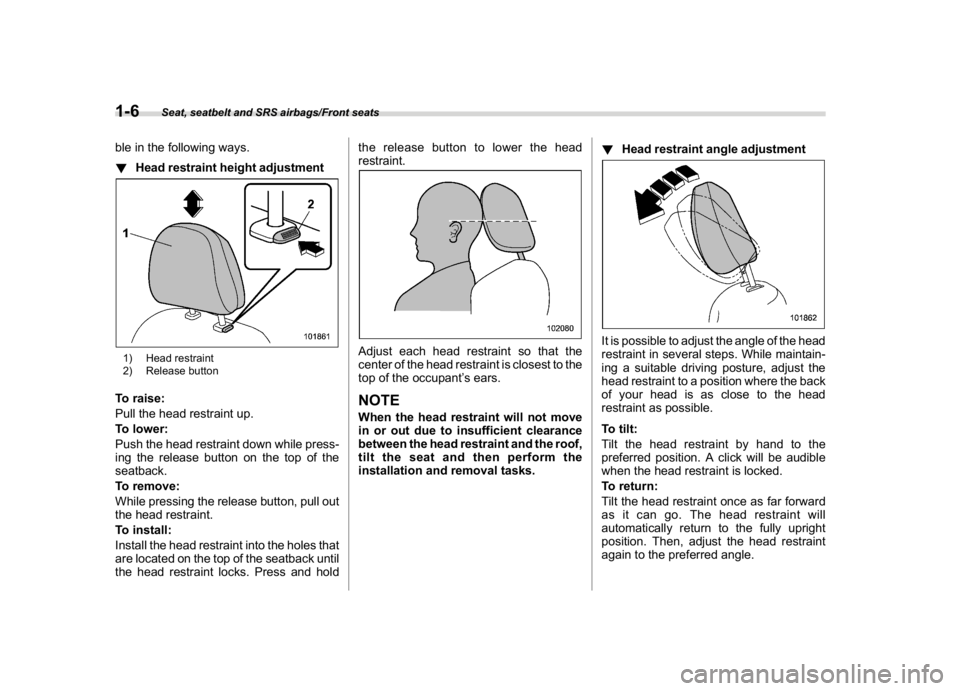
(38,1)
北米Model "A1700BE-B" EDITED: 2017/ 10/ 11
ble in the following ways.
!Head restraint height adjustment1) Head restraint
2) Release buttonTo raise:
Pull the head restraint up.
To lower:
Push the head restraint down while press-
ing the release button on the top of the
seatback.
To remove:
While pressing the release button, pull out
the head restraint.
To install:
Install the head restraint into the holes that
are located on the top of the seatback until
the head restraint locks. Press and holdthe release button to lower the head
restraint.
Adjust each head restraint so that the
center of the head restraint is closest to the
top of the occupant’s ears.NOTEWhen the head restraint will not move
in or out due to insufficient clearance
between the head restraint and the roof,
tilt the seat and then perform the
installation and removal tasks.!Head restraint angle adjustment
It is possible to adjust the angle of the head
restraint in several steps. While maintain-
ing a suitable driving posture, adjust the
head restraint to a position where the back
of your head is as close to the head
restraint as possible.
To tilt:
Tilt the head restraint by hand to the
preferred position. A click will be audible
when the head restraint is locked.
To return:
Tilt the head restraint once as far forward
as it can go. The head restraint will
automatically return to the fully upright
position. Then, adjust the head restraint
again to the preferred angle.
Seat, seatbelt and SRS airbags/Front seats
1-6
Page 40 of 578
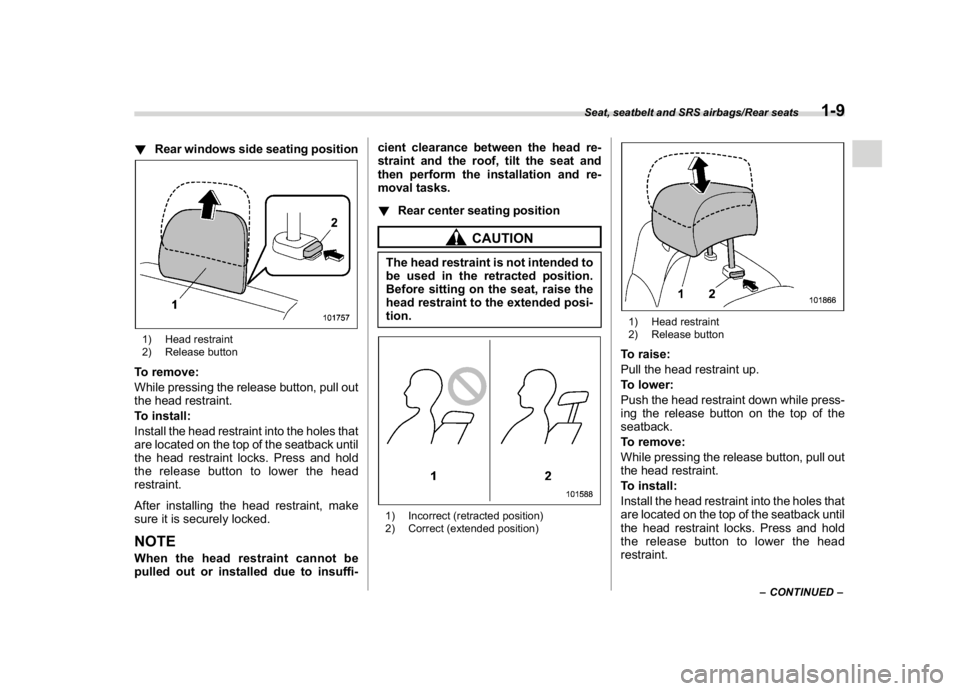
(41,1)
北米Model "A1700BE-B" EDITED: 2017/ 10/ 11
!Rear windows side seating position1) Head restraint
2) Release buttonTo remove:
While pressing the release button, pull out
the head restraint.
To install:
Install the head restraint into the holes that
are located on the top of the seatback until
the head restraint locks. Press and hold
the release button to lower the head
restraint.
After installing the head restraint, make
sure it is securely locked.NOTEWhen the head restraint cannot be
pulled out or installed due to insuffi-cient clearance between the head re-
straint and the roof, tilt the seat and
then perform the installation and re-
moval tasks.
!Rear center seating position
CAUTION
The head restraint is not intended to
be used in the retracted position.
Before sitting on the seat, raise the
head restraint to the extended posi-
tion.1) Incorrect (retracted position)
2) Correct (extended position)
1) Head restraint
2) Release buttonTo raise:
Pull the head restraint up.
To lower:
Push the head restraint down while press-
ing the release button on the top of the
seatback.
To remove:
While pressing the release button, pull out
the head restraint.
To install:
Install the head restraint into the holes that
are located on the top of the seatback until
the head restraint locks. Press and hold
the release button to lower the head
restraint.
–CONTINUED–
Seat, seatbelt and SRS airbags/Rear seats
1-9
1
Page 66 of 578
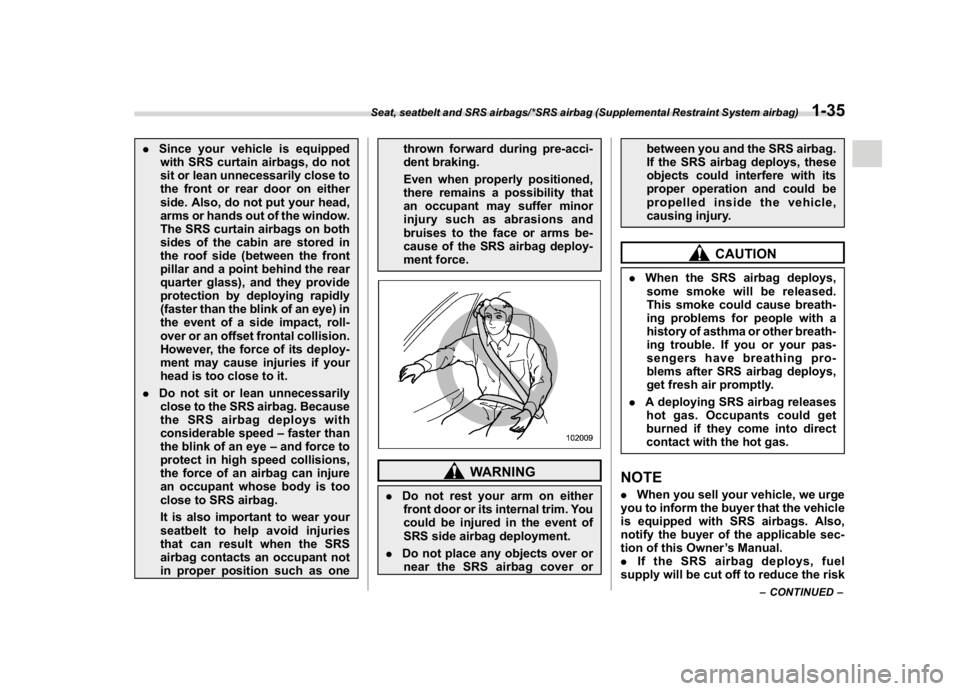
(67,1)
北米Model "A1700BE-B" EDITED: 2017/ 10/ 11
.Since your vehicle is equipped
with SRS curtain airbags, do not
sit or lean unnecessarily close to
the front or rear door on either
side. Also, do not put your head,
arms or hands out of the window.
The SRS curtain airbags on both
sides of the cabin are stored in
the roof side (between the front
pillar and a point behind the rear
quarter glass), and they provide
protection by deploying rapidly
(faster than the blink of an eye) in
the event of a side impact, roll-
over or an offset frontal collision.
However, the force of its deploy-
ment may cause injuries if your
head is too close to it.
.Do not sit or lean unnecessarily
close to the SRS airbag. Because
the SRS airbag deploys with
considerable speed–faster than
the blink of an eye–and force to
protect in high speed collisions,
the force of an airbag can injure
an occupant whose body is too
close to SRS airbag.
It is also important to wear your
seatbelt to help avoid injuries
that can result when the SRS
airbag contacts an occupant not
in proper position such as onethrown forward during pre-acci-
dent braking.
Even when properly positioned,
there remains a possibility that
an occupant may suffer minor
injury such as abrasions and
bruises to the face or arms be-
cause of the SRS airbag deploy-
ment force.
WARNING
.Do not rest your arm on either
front door or its internal trim. You
could be injured in the event of
SRS side airbag deployment.
.Do not place any objects over or
near the SRS airbag cover orbetween you and the SRS airbag.
If the SRS airbag deploys, these
objects could interfere with its
proper operation and could be
propelled inside the vehicle,
causing injury.
CAUTION
.When the SRS airbag deploys,
some smoke will be released.
This smoke could cause breath-
ing problems for people with a
history of asthma or other breath-
ing trouble. If you or your pas-
sengers have breathing pro-
blems after SRS airbag deploys,
get fresh air promptly.
.A deploying SRS airbag releases
hot gas. Occupants could get
burned if they come into direct
contact with the hot gas.NOTE.When you sell your vehicle, we urge
you to inform the buyer that the vehicle
is equipped with SRS airbags. Also,
notify the buyer of the applicable sec-
tion of this Owner’s Manual.
.If the SRS airbag deploys, fuel
supply will be cut off to reduce the risk
–CONTINUED–
Seat, seatbelt and SRS airbags/*SRS airbag (Supplemental Restraint System airbag)
1-35
1
Page 72 of 578
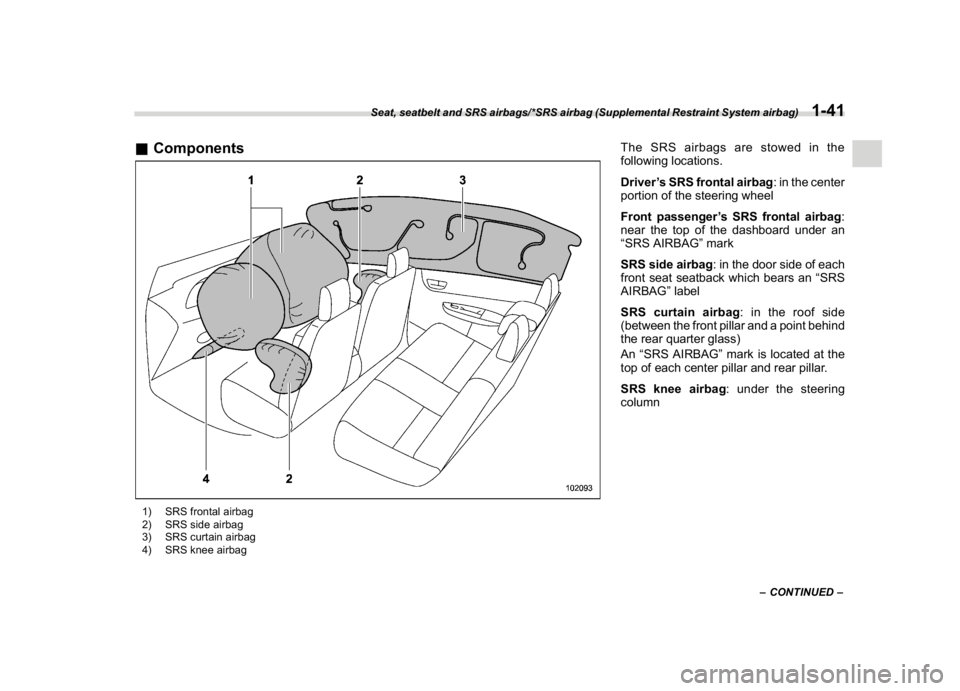
(73,1)
北米Model "A1700BE-B" EDITED: 2017/ 10/ 11
&Components1) SRS frontal airbag
2) SRS side airbag
3) SRS curtain airbag
4) SRS knee airbag
The SRS airbags are stowed in the
following locations.
Driver’s SRS frontal airbag: in the center
portion of the steering wheel
Front passenger’s SRS frontal airbag:
near the top of the dashboard under an
“SRS AIRBAG”mark
SRS side airbag: in the door side of each
front seat seatback which bears an“SRS
AIRBAG”label
SRS curtain airbag: in the roof side
(between the front pillar and a point behind
the rear quarter glass)
An“SRS AIRBAG”mark is located at the
top of each center pillar and rear pillar.
SRS knee airbag: under the steering
column
–CONTINUED–
Seat, seatbelt and SRS airbags/*SRS airbag (Supplemental Restraint System airbag)
1-41
1
Page 84 of 578
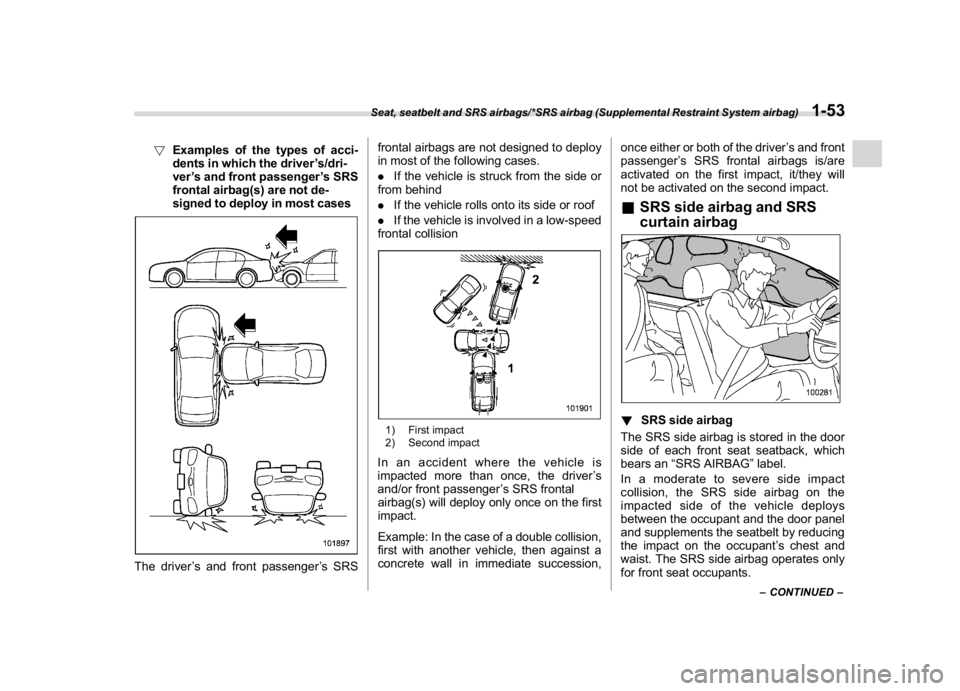
(85,1)
北米Model "A1700BE-B" EDITED: 2017/ 10/ 11
!Examples of the types of acci-
dents in which the driver’s/dri-
ver’s and front passenger’s SRS
frontal airbag(s) are not de-
signed to deploy in most cases
The driver’s and front passenger’s SRSfrontal airbags are not designed to deploy
in most of the following cases.
.If the vehicle is struck from the side or
from behind
.If the vehicle rolls onto its side or roof
.If the vehicle is involved in a low-speed
frontal collision
1) First impact
2) Second impactIn an accident where the vehicle is
impacted more than once, the driver’s
and/or front passenger’s SRS frontal
airbag(s) will deploy only once on the first
impact.
Example: In the case of a double collision,
first with another vehicle, then against a
concrete wall in immediate succession,once either or both of the driver’s and front
passenger’s SRS frontal airbags is/are
activated on the first impact, it/they will
not be activated on the second impact.
&SRS side airbag and SRS
curtain airbag!SRS side airbag
The SRS side airbag is stored in the door
side of each front seat seatback, which
bears an“SRS AIRBAG”label.
Inamoderatetoseveresideimpact
collision, the SRS side airbag on the
impacted side of the vehicle deploys
between the occupant and the door panel
and supplements the seatbelt by reducing
the impact on the occupant’s chest and
waist. The SRS side airbag operates only
for front seat occupants.
–CONTINUED–
Seat, seatbelt and SRS airbags/*SRS airbag (Supplemental Restraint System airbag)
1-53
1
Page 85 of 578
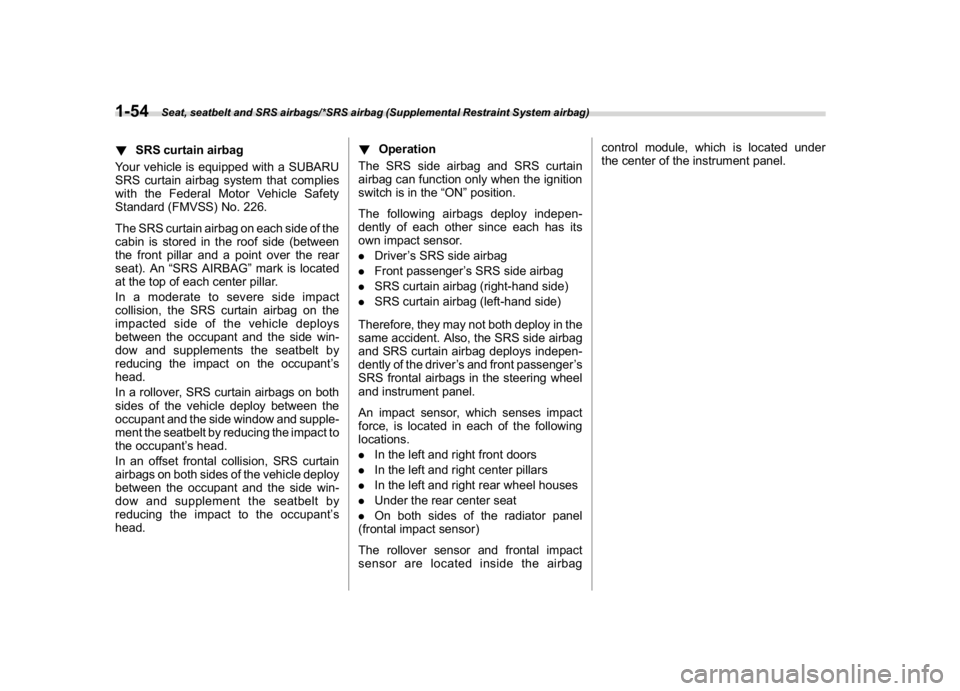
(86,1)
北米Model "A1700BE-B" EDITED: 2017/ 10/ 11
!SRS curtain airbag
Your vehicle is equipped with a SUBARU
SRS curtain airbag system that complies
with the Federal Motor Vehicle Safety
Standard (FMVSS) No. 226.
The SRS curtain airbag on each side of the
cabin is stored in the roof side (between
the front pillar and a point over the rear
seat). An“SRS AIRBAG”mark is located
at the top of each center pillar.
Inamoderatetoseveresideimpact
collision, the SRS curtain airbag on the
impacted side of the vehicle deploys
between the occupant and the side win-
dow and supplements the seatbelt by
reducing the impact on the occupant’s
head.
In a rollover, SRS curtain airbags on both
sides of the vehicle deploy between the
occupant and the side window and supple-
ment the seatbelt by reducing the impact to
the occupant’s head.
In an offset frontal collision, SRS curtain
airbags on both sides of the vehicle deploy
between the occupant and the side win-
dow and supplement the seatbelt by
reducing the impact to the occupant’s
head.!Operation
The SRS side airbag and SRS curtain
airbag can function only when the ignition
switch is in the“ON”position.
The following airbags deploy indepen-
dently of each other since each has its
own impact sensor.
.Driver’s SRS side airbag
.Front passenger’s SRS side airbag
.SRS curtain airbag (right-hand side)
.SRS curtain airbag (left-hand side)
Therefore, they may not both deploy in the
same accident. Also, the SRS side airbag
and SRS curtain airbag deploys indepen-
dently of the driver’s and front passenger’s
SRS frontal airbags in the steering wheel
and instrument panel.
An impact sensor, which senses impact
force, is located in each of the following
locations.
.In the left and right front doors
.In the left and right center pillars
.In the left and right rear wheel houses
.Under the rear center seat
.On both sides of the radiator panel
(frontal impact sensor)
The rollover sensor and frontal impact
sensor are located inside the airbagcontrol module, which is located under
the center of the instrument panel.
Seat, seatbelt and SRS airbags/*SRS airbag (Supplemental Restraint System airbag)
1-54